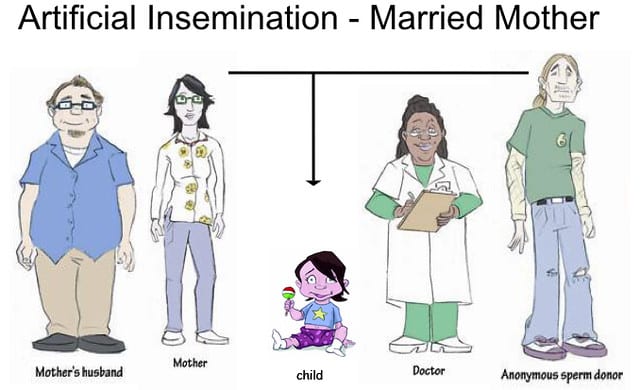What is Artificial Insemination?
Definition, Procedure & Benefits
Artificial Insemination or AI is a method of treating infertility where semen, either from the male partner or the donor, is injected directly into the female’s reproductive tract.
The sperm has to be implanted into the womb through any method except sexual intercourse for it to be considered artificial insemination. This direct placement facilitates the process of fertilization and increases the chances of conception, significantly.
Also known as intrauterine insemination or IUI, this procedure is part of assisted reproductive techniques that are used to treat unexplained infertility with low sperm counts.
Although IUI and AI are considered to be synonymous, IUI is a type of AI, just like intra-tubal insemination (ITI), intra-cervical insemination (ICI), and intrauterine subperitoneal insemination (IU-TBI), which all refer to the different locations where sperm is injected into.
In the case of both female and male infertility, IUI or AI is performed along with ovarian stimulation using medications to promote ovulation.
A Brief History of Artificial Insemination
Artificial insemination was performed for the first time in London in the 1770s by Dr. John Hunter, who is also known as the founder of scientific surgery.
He published his results in the 1790s and is credited with applying artificial insemination successfully. Before the attempts of Hunter, many unofficial reports exist of conquerors and kings trying to apply and use AI techniques.
After Hunter, several American, Russian, and English scientists and researchers attempted and succeeded in improving the procedure and finally being able to apply the techniques using donor sperm.
Further advances were made in 1953 by Dr. Jerome K. Sherman who tried to use frozen sperm for IUI procedures. Since its first-ever successful application, AI has come a long way and still has a long way to go.
Is Artificial Insemination Efficient?
Artificial insemination is an effective method of treatment depending on the severity and cause of infertility. The success rate of the procedure is quite high, approximately 15 percent to 20 percent per cycle.
The rates undergo a drastic increase from 50 percent to 60 percent, after five to six cycles of artificial insemination.
An AI cycle is considered to be successful if it results in pregnancy, however, it is important to note that pregnancy doesn’t just depend on insemination but also other factors and isn’t the best indicator of success.
Another important aspect to keep in mind is that pregnancy doesn’t always end in childbirth, and pregnancies as a result of artificial insemination were studied closely and regular follow-up was done to ensure the fetus was healthy and free of congenital disorders.
In very rare cases, artificial insemination can result in these disorders but that is less related to the procedure and more related to the genetic makeup of both parents.
Artificial Insemination is a safe procedure when performed by trained professionals and its safety along with efficacy are proven in several medical publications and literature.
A retrospective study conducted to test pregnancy rates after AI treatment and the effect of other factors on the results, such as maternal age had some interesting findings.
This study was conducted on Chinese residents who underwent the AI procedure and it was found that as maternal age increased, success rates of AI decreased significantly.
However, during the reproductive age period, the application of AI was shown to result in pregnancy, within the first six cycles.
Candidate for Artificial Insemination
Artificial Insemination is a popular infertility treatment method but it does not apply to every type of infertility. Certain criteria need to be met before undergoing artificial insemination.
This is done to protect the mother or the surrogate from developing adverse health effects and to ensure that a viable pregnancy is an option. To be a candidate for artificial insemination:
- An infertility diagnosis must be made. For a couple under the age of 35 years, infertility refers to lack of conception despite having unprotected sex for 12 months or 1 year. A couple over the age of 35 is referred to as infertile if there has been no conception after having unprotected sex for 6 months.
- Semen analysis needs to be done. This is done to assess if there is enough sperm, if the sperm is motile, and if the sperm is healthy enough to move toward the egg and fertilize.
- Ovarian reserve needs to be checked to ensure that the woman has eggs that the sperm can fertilize with, resulting in a viable pregnancy.
- Both partners should be healthy, both physically and mentally.
In general, Assisted Reproductive Techniques like AI is an effective, safe, and readily available methods of treating infertility if performed by a medical professional.
The criteria to undergo the procedure must be met to ensure that AI will not result in adverse effects for the mother or the surrogate.
Having a candid discussion with your healthcare provider can facilitate the entire process and increase the chances of success. Here is an IVF Success Rate Calculator for you to have a general idea against the odds.
References
- Zhang A, Ma X, Zhang L, Zhang X, Wang W. Pregnancy and offspring outcomes after artificial insemination with donor sperm: A retrospective analysis of 1805 treatment cycles performed in Northwest China. Medicine (Baltimore). 2019;98(16):e14975. doi:10.1097/MD.0000000000014975 https://pubmed.ncbi.nlm.nih.gov/
- Omelet W, Van Robays J. Artificial insemination history: hurdles and milestones. Facts Views Vis Obgyn. 2015;7(2):137-143. https://www.ncbi.nlm.nih.gov/pmc/articles/
- Vishwanath R. Artificial insemination: the state of the art. Theriogenology. 2003 Jan 15;59(2):571-84. https://pubmed.ncbi.nlm.nih.gov/
See Also
What is In Vitro Fertilization
